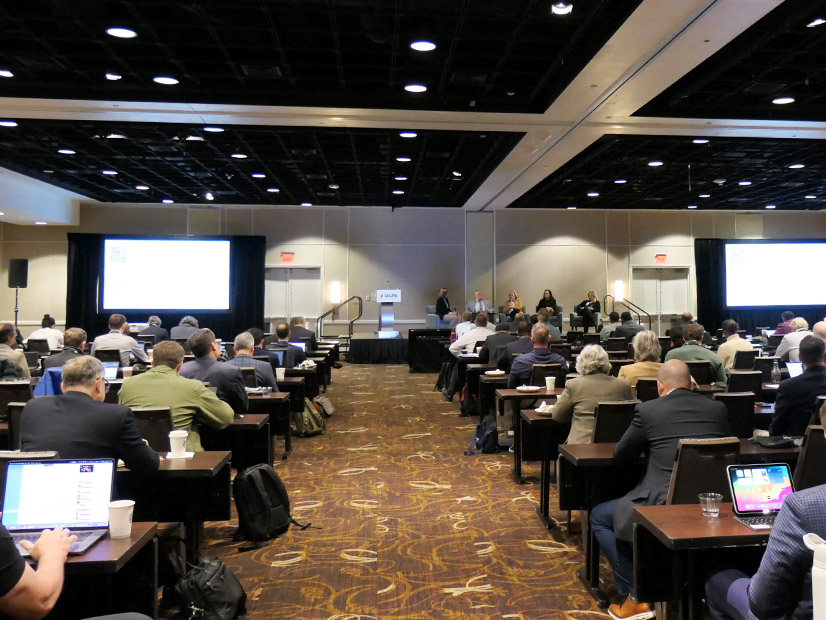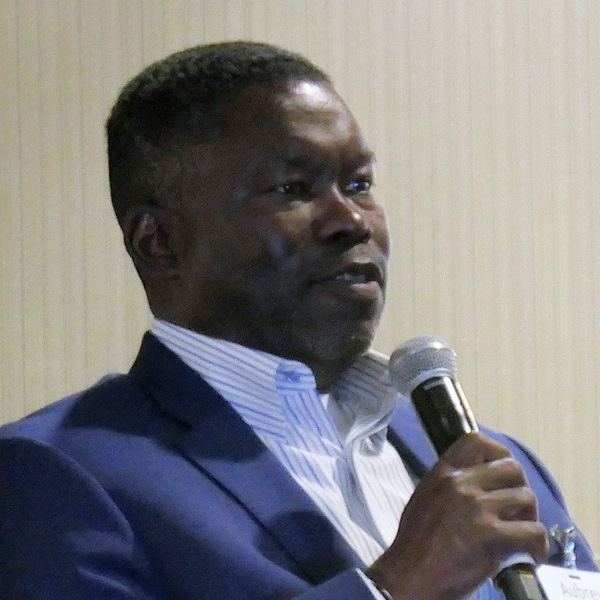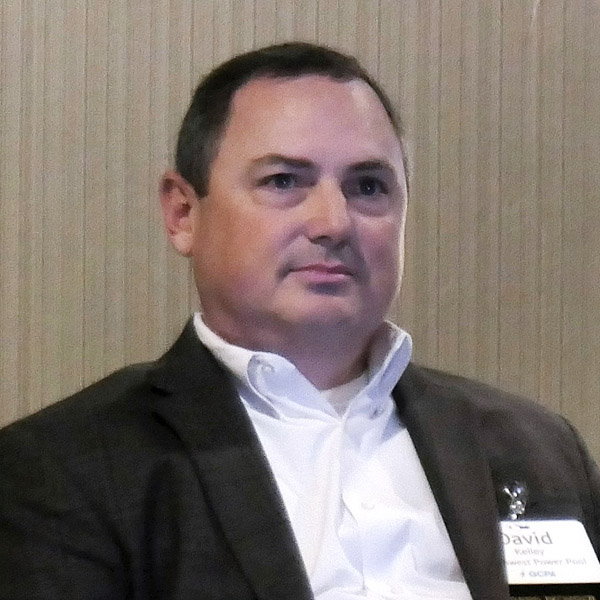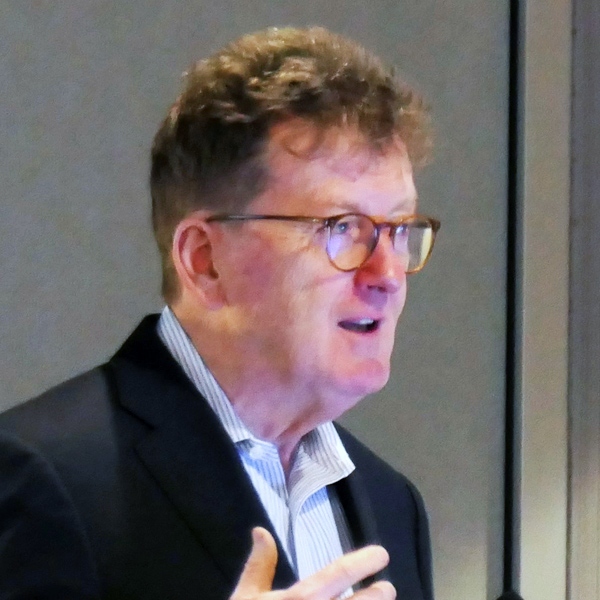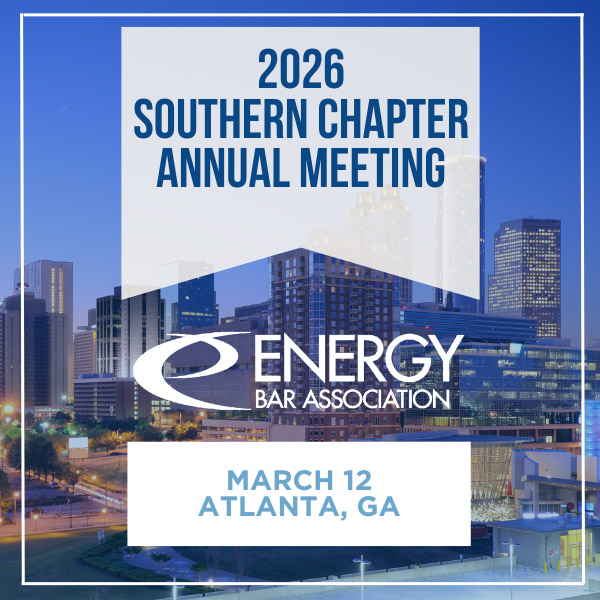NEW ORLEANS — Speaking at an annual conference, MISO and SPP executives promised to open their queues’ floodgates.
Generation developers, however, laid out why generation construction remains tricky. And data center developers kept up calls for quick additions.
At the Gulf Coast Power Association’s MISO-SPP conference Feb. 19-20, SPP Vice President of Engineering Casey Cathey likened interconnection queue improvements to family reunions, where everyone agrees it needs to happen, but no one knows “the timing, where to go, who to pay and who has the power.”
During a panel on queue improvements dubbed “It’s a Cluster,” Cathey said SPP first must clear its queue backlog, where it has squeezed seven years of project cycles into three years of processing. SPP then hopes to introduce a consolidated planning process that would marry transmission planning with generator interconnection.
Cathey said SPP wants interconnection customers to know their total costs at the beginning of the queue, though he said it’s incumbent on developers to arrive having done substantial leg work on their projects.
SPP has more than 100 GW in its interconnection queue. Cathey estimates just 40% of the projects are viable, with only a quarter of those projects’ installed capacities ultimately being accredited.
Vice President of System Planning Aubrey Johnson said MISO has “been in some form of generator interconnection reform” over his seven years there. He said MISO believes its planned, backbone transmission projects will pare down network upgrade costs.
MISO’s queue contains 313 GW across 1,710 generation projects. The grid operator awaits about 57 GW of approved generation to come online. Johnson said about 27 GW of the delayed projects are more than two years behind stated commercial operation dates.
Johnson said in the 2025/26 capacity auction, MISO could be 2.7 GW short of meeting its planning reserve margin. He said risk is “knocking at” MISO’s door while construction timetables stretch out.
“We have a clear and present question today of how we’re going to meet the calls of our load-serving entities who have all this load coming on,” Johnson said. He said MISO’s plan to introduce a fast lane for certain projects that have regulator support and its efforts to automate studies with tech startup Pearl Street should help.
EDP Renewables’ David Mindham asked how the RTOs plan to handle the issue that load-serving entities likely will be favored in their respective expedited lanes over independent power producers.
Johnson stressed that the fast lane will be limited to a few queue cycles and then discontinued.
“This is in a box. This is not how we see life going on,” Johnson said. He added that he and his team are caught between the immediate reliability danger that necessitates MISO’s accelerated — albeit temporary — queue processing for select projects and achieving an automated study process that produces speedy study results for all interconnection customers.
Johnson said it would be beneficial if the U.S. Department of Energy would invoke the Defense Production Act to speed up the manufacture of transformers.
When asked what advice he had for interconnection customers, Johnson didn’t mince words.
“The first is: Build. Build,” he emphasized. “The second is: We’re getting faster. Get ready.”
SPP CFO David Kelley said if he could snap his fingers and fix anything in SPP, he’d be able to “press a button” to get instant study results on the precise level of transmission and generation development needed while those projects overcome challenges of permitting and siting and “getting hands on equipment.”
“Technology is moving so fast around us,” Kelley said, presenting a challenge for an industry “not known for” keeping up with technology.
Kelley said MISO and SPP alike are making concerted efforts to partner with technology companies and recruit those with skillsets in automation and AI for their operations.
Kelley borrowed a line from SPP CEO Barbara Sugg, who was unable to attend the conference, to sum up the zeitgeist. “What got us here won’t get us there,” he said.
‘Delayed, Delayed, Delayed’
“I think we have an energy scarcity five to 10 years out, and we have no path to build energy resources, it seems like. All the renewables we thought were going to come online are delayed, delayed, delayed,” said Colton Kennedy, Omaha Public Power District director of energy portfolio planning. He added that the firm supply from small modular reactors isn’t on the horizon at least until 2035, if one is optimistic.
Kennedy said resource planning has become knottier because developers aren’t sure what the future accreditation of their resources will be, since the overall energy mix influences those values. He said RTOs might consider levying the costs for ramping on those responsible for the needs, whether that be wind generation that dips or load that ratchets up suddenly.
Pattern Energy Vice President of Origination Holly Adams said RTOs’ current five- to six-year wait time in the queue isn’t “palatable” to generation developers. She also said the now-unstable status of tax credits, permitting reform and tariffs under the new presidential administration makes development an increasingly riskier proposition.
Adams added that severe weather episodes are causing insurance rates to skyrocket, with developers confronted with spending more to insure their projects.
More Expensive RA
Julien Dumoulin-Smith, a managing director at Jefferies, said it’s a reality that the price point of resource adequacy will continue to rise with inflation. He said many in the industry failed to appreciate the “writing on the wall’ a few years ago as labor costs and the capital costs of equipment began to rise.
“That’s the reality on the ground,” Dumoulin-Smith said. He estimated that the industry is at the beginning of an inflationary cycle and equipment will trend higher.
Electric Power Research Institute’s Justin Sharp said the industry needs more multidisciplinary expertise to understand how extreme weather conditions set off interconnected consequences in a shifting energy mix. He said it’s concerning the industry doesn’t fully grasp its evolving resource adequacy risk.
“I’ve got a presentation that I’ve given many places that basically says, ‘We’re flying blind,’” Sharp said, calling for “high-quality ground truth data” from generation owners.
Adams said that because no one really knows what technology will be developed over the next 20 years, generation should be judged by objective measurements like ramp rates instead of lumping generation types like natural gas together.
“It is not inconceivable, but it’s inevitable that we’re going to have eight- to 10-hour batteries,” Dumoulin-Smith added.
Dumoulin-Smith added that there’s a “serious discrepancy” between the energy delivery that data centers want and what utilities tell them is possible. He said that tension should create opportunities for independent power producers, arguing that’s what they were made for.
Dumoulin-Smith predicted that data center developers will push the envelope of what’s possible through innovation. He asked the audience rhetorically what’s going to happen when utilities cannot announce another coal plant extension or when they hit their limit on adding gas plants.
Organization of MISO States Executive Director Tricia DeBleeckere said while natural gas is helpful, there’s a limit to how many new gas plants can be built. She said utilities must be creative to source new capacity.
Adams said data centers require a 99.9% capacity factor that’s possible only with access to a wholesale market, possibly through future HVDC lines.
Louisiana Public Service Commissioner Mike Francis said he remains confident that natural gas buildout is the best bet for his state. He said that’s evidenced by Meta selecting Louisiana for a campus and striking a deal for a trio of gas plants with Entergy. (See Entergy La. Confirms Meta Data Center Behind 3 Proposed Gas Plants.)
“We have a lot of gas in the ground, it’s God-given, and we need to use it,” he said. “Let’s go back and open the doors on that fuel supply.”
“Data center, data center, data center — and crypto mining. That’s all we’re talking about in Oklahoma,” Oklahoma Corporation Commission Chair Kim David said.
David said though some data center developers are weighing building gas plants behind the meter, Oklahoma needs to make sure the data boom is regulated and doesn’t become the “Wild West.”
She said even if data center developers are successful in building their own plants behind the grid, they inevitably will want to interconnect to sell excess power. She said it’s a challenge to quell an attitude of manifest destiny from her legislature, governor’s office and data center developers.
“We’re all dealing with that type of mentality. But they don’t realize that we’re all connected. They’re not on an island just by themselves. If they want to be, great. … But that’s not how it’s going to happen,” she said, predicting that data centers will want backup wholesale power when their own plants inevitably experience outages.
David said in the meantime, her state is seeking the most reliable and cheapest mix of energy. She told the audience not to count out coal yet, noting that SPP on Feb. 19 likely met an all-time peak winter demand with coal’s help.
David said she hopes federal environmental regulations around natural gas “loosen up” so more plants can be built. But she said to get accredited capacity built to meet resource adequacy targets, grid operators’ interconnection queues must be efficient in getting resources connected.
‘Fits and Starts’
While many panelists said the past is no indication for the future grid, Grid United CEO Michael Skelly argued the industry can look back on the power industry’s trajectory of the past 140 years to get a general picture of how the grid stands to evolve now.
He said it’s “worth remembering” that it took John F. Kennedy’s presidential leadership to accomplish the Pacific DC Intertie. He also said the public has Jimmy Carter to thank for wind, hydropower and gas turbine advancements through the Public Utility Regulatory Policies Act.
Skelly said the demand for low-carbon resources won’t recede despite President Trump’s second administration. He said carbon-cutting measures remain priorities across polls.
“Progress in this area, I’ll remind my younger colleagues, is not always linear,” Skelly told the audience.
Skelly took a longer view of the data center issue and asked attendees to consider what happens if the power needs fade after a few decades and utilities are left needing to recoup the cost of expensive assets.
“We need to ask a lot of hard questions about this. I think people are still a little shy on this topic,” he said. Skelly said the “argument isn’t tight as in years past” that consumers should be willing to bear some risk as it was during and after World War II, for instance.
“In any event, we know we’re going to need a lot more grid,” Skelly said. He said the grid of tomorrow will be built in “fits and starts” and spring up organically as it has for decades, not from any centralized plans.
Finally, Skelly appealed to companies to consider hiring recently purged Department of Energy employees.
“There really is a great pool of talent in the Grid Deployment Office, so keep an eye out for them on LinkedIn,” he said.
Others treated data center load growth as more concrete and lasting.
“It’s a staggering amount of power being asked from the grid,” said Phillip Sandino, a senior vice president at Tract Capital Management, a firm specializing in master planning data center locations.
Sandino said complicating matters, local governments and regulators are becoming more antagonistic to ever-larger data center campuses.
“You all know that, because it’s not like they’re throwing rose petals in front of you to develop,” Sandino addressed the generation and transmission developers in the crowd.
“The growth we’re seeing is beyond anything I’ve seen in my career… I can’t overstate how big a deal this is,” Entergy Louisiana CEO Phillip May said. He likened today’s levels of load growth to the 1940s and 1950s when the U.S. economy swapped war production with post-war consumerism and housing. However, May said he and his team are careful not to accept new customers that ultimately will burden ratepayers.
Silicon Ranch Vice President of Interconnection and Policy Myra Sinnott said hyperscalers, regulators, utilities and grid operators should “open the channels of communication” where they can so everyone has a better understanding of what’s to come.
“A lot of these large load developers are desperate for power,” Sinnott said. She said grid operators and utilities should find creative ways to work faster within the confines of existing rules.
Meta Energy Manager Paul Kelly said when Meta is looking for a site, it’s looking for a utility that conveys confidence and can move fast to serve new load.
Amazon Manager of Energy Policy Ray Fakhoury said siting data facilities has shifted recently from tech companies selecting locations to letting power providers direct them to appropriate locations. He said Amazon has a preference to be in front of the meter.
Chris Matos, of Google’s energy market development division, conceded that data centers need non-interruptible sources, a challenge as the industry struggles to add accredited capacity.
“The buzzword is AI, but these data centers are cloud computing for the most part,” Matos said, adding that when data centers are interrupted, essential services like hospital records and financial markets are endangered.
MISO Executive Director of Markets Innovation and Strategy Zak Joundi said exploding data center demand doesn’t change MISO’s playbook for handling the energy transition. But, he said, it does have MISO doubling down on some of its recent projects, including a new availability-based generation accreditation, an expedited lane in its interconnection queue and more visibility into its risk profile. He said MISO already was modeling and preparing for a complex system with the energy transition before large loads began lining up to connect.
“You have a velocity aspect, you have a magnitude aspect added to the equation,” Joundi said. “But there is no indication we have big gaps.”
SPP Director of System and Resource Planning Natasha Henderson said SPP’s planned expedited queue lane and its provisional load study process — where the RTO forecasts future demand to plan grid upgrades — should help SPP better respond to load growth.
“We need to continue to add tools, add processes,” she said of the path ahead.
Henderson also said there’s no question SPP will need long-duration storage to navigate windless and cloudy periods.
“You can look at CAISO and where they’re going and where they’ve been,” she said.
Interregional Tx as Insurance
Liz Salerno, a principal at consulting firm GQS New Energy Strategies, said the time is right for FERC to make an interregional planning rule. She said expanded transfer capability is an insurance policy against system collapse, though she acknowledged that cost allocation between regions will be a rocky endeavor at best.
Salerno said the good planning FERC’s Order 1920 prescribes will prevent the industry from playing “Whac-A-Mole” with reliability issues, and FERC should do the same on an interregional scale.
“One storm. One storm pays for itself,” she said. “All the dominos are lined up for FERC to act on this.”
MISO’s Laura Rauch agreed on the insurance characterization of interregional projects but said it’s a challenge to get separate regions to agree on a risk tolerance for interregional projects “without resorting to the bare minimum.” She said MISO’s interregional planning strives to land on “shared truths” between geographies even though “everyone’s crystal ball is cracked and cloudy.”
Karen Onaran, CEO of industrial trade association ELCON, said when FERC staff drafted Order 1920, they likely didn’t realize load growth was set to surge. She said the commission’s emphasis on 20-year planning makes even more sense as load additions pile up.
“We can no longer rely on historical numbers to plan the grid of the future,” Onaran said.
Onaran urged stakeholders to “lower their temperature” on cost allocation and not get so hung up on whether every last mile of line benefits their territories. She said interregional transmission planning doesn’t further one state’s sustainability goals at the expense of ratepayers in another state.
